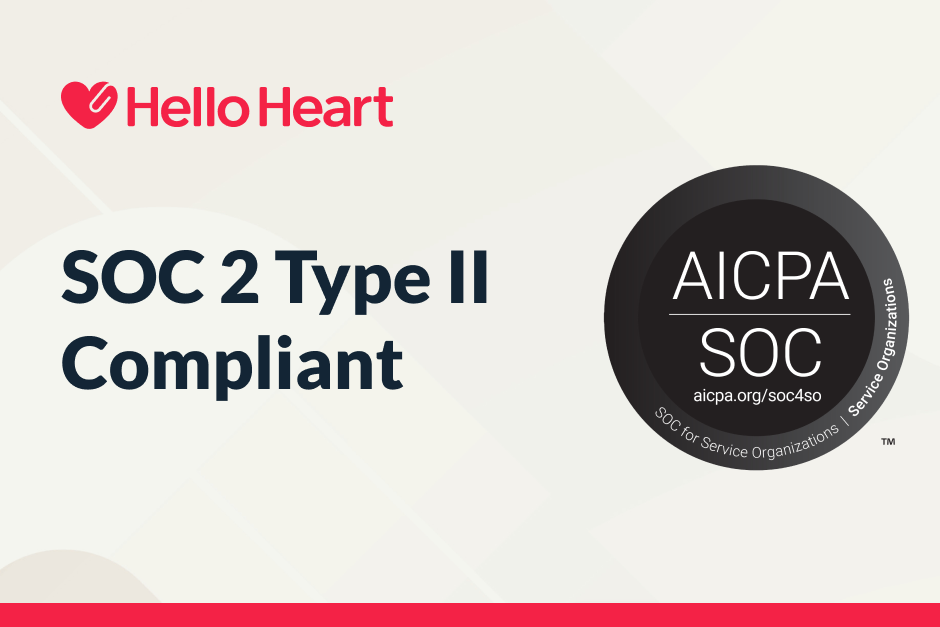When health and benefit leaders explore ways to promote women’s health throughout their organization, breast cancer or reproductive health may be top of mind.
However, there is one women’s health issue that is even more prevalent and potentially fatal than breast cancer. To help benefit leaders get a clearer and more complete picture of the women’s health landscape and the gaps in care — and ultimately help them identify the most relevant, impactful, and timely resources and tools to empower the women in their workforce — Hello Heart is taking a deep dive into top women’s health concerns that may get overlooked or crowded out, starting with heart disease.
What is heart disease?
Heart disease is any condition that affects the structure or function of the heart. There are multiple types of heart disease, which are typically categorized into four groups:
- Heart failure, which is most commonly caused by high blood pressure (hypertension) and heart attack.
- Coronary artery and vascular disease, which is due to hardening of the arteries (atherosclerosis).
- Heart rhythm disorders (arrhythmias), which cause the heart to beat too slowly, too quickly, or in a disorganized fashion.
- Structural heart disease, which refers to abnormalities of the heart’s structure, including valves, walls, muscles, or blood vessels located near the heart.
How many women in the United States have heart disease?
Among women 20 years and older, nearly 45% have some form of cardiovascular disease. Women over 60 are more likely than men to have hypertension, yet less likely to have it under control. Also, hypertension is more closely linked with heart attacks in women vs. men. 1 in 3 women will develop heart disease at some point in their lifetime, compared with 1 in 8 who will get breast cancer.
How deadly is heart disease for women?
Heart disease is the leading cause of death for women in the U.S., and is responsible for about 1 in every 3 female deaths. Many women don't know that heart disease is 7x deadlier than breast cancer, and that nearly 52% of high blood pressure deaths — otherwise known as hypertension or the “silent killer” — are in women. And while heart disease is often thought of as primarily a men’s health issue, since 1984 more women have died each year from heart disease than men. Overall, heart disease kills more women than lung cancer, breast cancer and colon cancer combined.
What is the financial impact of heart disease?
Cardiovascular disease is the most expensive chronic disease in the U.S. with an overall price tag of about $363 billion each year.1 Cardiovascular disease is also among the top (if not number one) driver of claims costs for many self-insured employers. In addition:
- The average cost of bypass surgery is $151,271.
- The average cost of a cardiac stent is $32,230.
- The average total medical spending per year for each individual with hypertension is $9,842.2
What’s more, 1 in 7 stent procedures for patients with stable heart disease are unnecessary, invasive procedures in patients with stable heart disease have not been shown to reduce the risk of cardiovascular events or death, and unnecessary cardiac procedures are one of the key areas that authorities are investigating related to healthcare fraud and abuse.
Symptoms
Compared to men, women are more likely to have heart attack symptoms unrelated to chest pain, such as:
- Neck, jaw, shoulder, upper back or upper belly (abdomen) discomfort
- Shortness of breath
- Pain in one or both arms
- Nausea or vomiting
- Sweating
- Feeling lightheaded or dizzy
- Unusual fatigue
- Heartburn (indigestion)
Often, women’s heart attack symptoms may get mistaken for anxiety which may impact the high mortality rate for heart attacks for women compared to men.
What are common causes of heart disease in women?
It’s important to be aware of what can increase women’s risk for heart disease and stroke in order to begin to take steps to reduce risk. Some of the top risk factors include:
- Hypertension
- Low level of HDL cholesterol (a.k.a. “good cholesterol”), or a high level of LDL cholesterol (a.k.a. “bad cholesterol”)
- Diabetes
- Lack of exercise
- Smoking
- Depression and stress
- Family history
- Obesity
There are some common risk factors like high blood pressure and high cholesterol that affect everyone. However, many people may not be aware that there are some risk factors that have sex-based differences that can put women at a higher risk, or that are unique to women. View this infographic to see the differences in risk factors.
Heart disease treatments
The Yale School of Medicine highlights four common, medically-approved recommendations options that have been shown to help women reduce their risk of developing or treating heart disease:
- Lifestyle changes, which includes following a heart-healthy healthy diet; starting a regular (and physician-approved) exercise routine; quitting smoking; reducing intake of salt, fat, added sugar, and alcohol.
- Prescription medication(s), which may lower blood pressure and/or high cholesterol, and reduce the risk of further complications. Women who have, are at risk of developing, blood clots may also be prescribed daily blood thinning medications.
- Interventional or surgical procedures, which may be necessary if a woman has blockage in the arteries.
- Cardiac rehabilitation, which is a program that includes regular meetings with cardiologists, exercise physiologists, nutritionists, and other health professionals.
Tips to prevent heart disease
One of the most effective things that women can do is track and manage their current health conditions, including high blood pressure and high cholesterol. For example, employers can empower the women in their workforce by offering Hello Heart as an employee benefit.
The Hello Heart app, which comes with a FDA-cleared blood pressure monitor, empowers women to easily track their blood pressure and cholesterol over time, and the option to securely share their readings with their physicians right from the app. In a peer-reviewed study published in a JAMA Network Open, Hello Heart’s hypertension self-management program was clinically shown to reduce blood pressure.3 It also led to a 2X improvement in reducing blood pressure compared to other digital heart health options on the market.4
The U.S. Food and Drug Administration (FDA) offers additional heart disease prevention tips:
- Know your risk factors.
- Recognize symptoms of a heart attack, and do not hesitate to call 9-1-1 if needed — research has found that women suffering a heart attack typically waited 37 minutes longer than men before calling an ambulance.
- Perform regular physical activity, and maintain a healthy weight.
- Make heart-healthy food choices.
- Be aware that daily use of aspirin is not right for everyone.
- Quit smoking.
Hello Heart can help bridge the health literacy gap when it comes to women’s heart health by providing personalized digital coaching with insights on lifestyle changes to action these prevention tips while also providing born gender-specific user flows for heart attack symptoms and cholesterol management. Learn more about the deadliest gap in care for women in this women's health infographic.
1 This includes heart disease and stroke, which are both related to heart health.
2 Figure calculated as part of Validation Institute’s analysis of Hello Heart cost savings. Source: Validation Institute. 2021 Validation Report (Valid Through October 2022). https://validationinstitute.com/wp-content/uploads/2021/10/Hello_Heart-Savings-2021-Final.pdf. Published October 2021. Accessed 30/7/22. (This analysis was commissioned by Hello Heart, which provided a summary report of self-funded employer client medical claims data for 203 Hello Heart users and 200 non-users from 2017-2020. Findings have not been subjected to peer review.)
3 Gazit T, Gutman M, Beatty AL. Assessment of Hypertension Control Among Adults Participating in a Mobile Technology Blood Pressure Self-management Program. JAMA Netw Open. 2021;4(10):e2127008, https://doi.org/10.1001/jamanetworkopen.2021.27008. Accessed 7/17/2022. (Some study authors are employed by Hello Heart. Because of the observational nature of the study, causal conclusions cannot be made. There were 108 participants with baseline blood pressure over 140/90 who had been enrolled in the program for 3 years and had application activity during weeks 148-163. See additional important study limitations in the publication.)
4 Sources: (1) Gazit T, Gutman M, Beatty AL. Assessment of Hypertension Control Among Adults Participating in a Mobile Technology Blood Pressure Self-management Program. JAMA Netw Open. 2021;4(10):e2127008, https://doi.org/10.1001/jamanetworkopen.2021.27008. Accessed 7/17/2022. (Some study authors are employed by Hello Heart. Because of the observational nature of the study, causal conclusions cannot be made. See additional important study limitations in the publication. This study showed that 108 participants with baseline blood pressure over 140/90 who had been enrolled in the program for 3 years and had application activity during weeks 148-163 were able to reduce their blood pressure by 21 mmHg using the Hello Heart program.) (2) Livongo Health, Inc. Form S-1 Registration Statement. https://www.sec.gov/Archives/edgar/data/1639225/000119312519185159/d731249ds1.htm. Published June 28, 2019. Accessed 7/3/2022. (In a pilot study that lasted six weeks, individuals starting with a blood pressure of greater than 140/90 mmHg, on average, had a 10 mmHG reduction.) NOTE: This comparison is not based on a head-to-head study, and the difference in results may be due in part to different study protocols.
1. Gazit T, Gutman M, Beatty AL. Assessment of Hypertension Control Among Adults Participating in a Mobile Technology Blood Pressure Self-management Program. JAMA Netw Open. 2021;4(10):e2127008, https://doi.org/10.1001/jamanetworkopen.2021.27008. Accessed October 19, 2022. (Some study authors are employed by Hello Heart. Because of the observational nature of the study, causal conclusions cannot be made. See additional important study limitations in the publication. This study showed that 108 participants with baseline blood pressure over 140/90 who had been enrolled in the program for 3 years and had application activity during weeks 148-163 were able to reduce their blood pressure by 21 mmHg using the Hello Heart program.) (2) Livongo Health, Inc. Form S-1 Registration Statement. https:/www.sec.gov/Archives/edgar/data/1639225/000119312519185159/d731249ds1.htm. Published June 28, 2019. Accessed October 19, 2022. (In a pilot study that lasted six weeks, individuals starting with a blood pressure of greater than 140/90 mmHg, on average, had a 10 mmHG reduction.) NOTE: This comparison is not based on a head-to-head study, and the difference in results may be due in part to different study protocols.
2. Validation Institute. 2021 Validation Report (Valid Through October 2022). https://validationinstitute.com/wp-content/uploads/2021/10/Hello_Heart-Savings-2021- Final.pdf. Published October 2021. Accessed October 19, 2022. (This analysis was commissioned by Hello Heart, which provided a summary report of self-fundedemployer client medical claims data for 203 Hello Heart users and 200 non-users from 2017-2020. Findings have not been subjected to peer review.)

.png)
.jpg)


